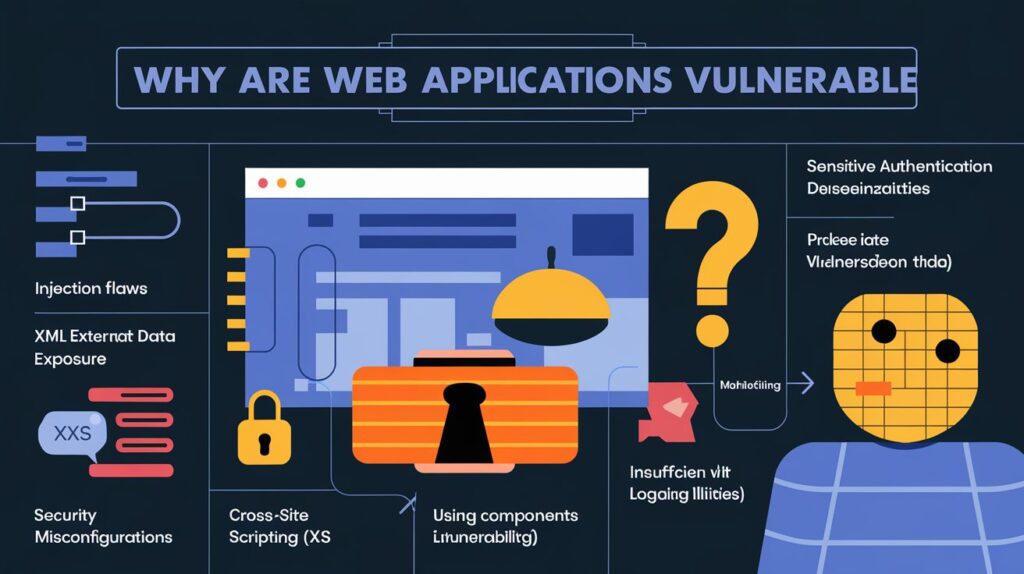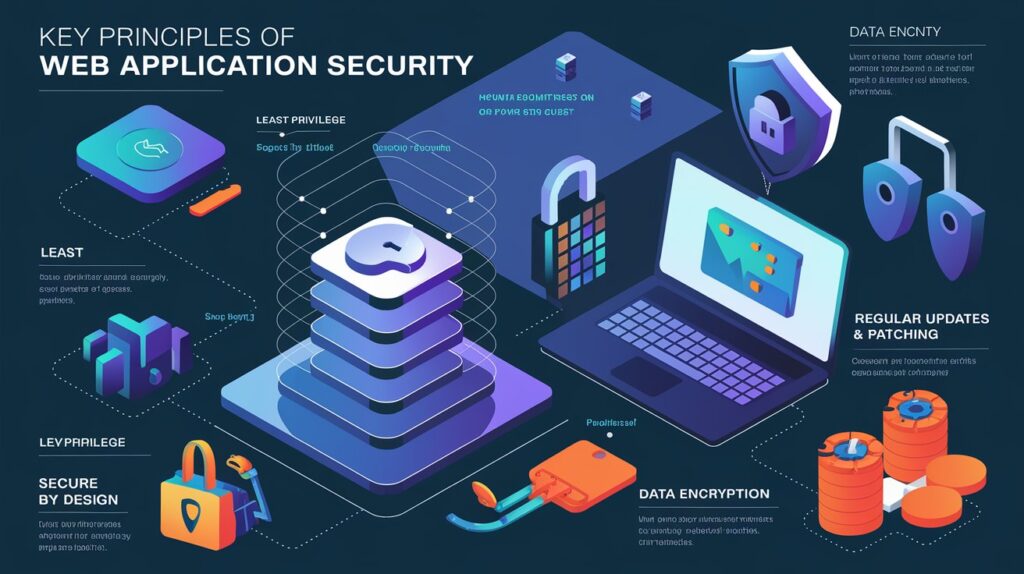Web application security is one of the most critical skills in today’s digital world. With cyberattacks becoming more sophisticated, protecting web applications from vulnerabilities is no longer optional—it’s a necessity. Whether you’re a developer, an IT professional, or someone looking to break into cybersecurity, learning web application security can open doors to exciting career opportunities and help you build safer digital experiences.
In this guide, we’ll walk you through everything you need to know to get started with web application security (Learn Web Application Security). From understanding the basics to mastering advanced techniques, we’ll cover it all in simple, easy-to-follow steps.
1. Understanding Web Applications:
Before we talk about security, let’s first understand what web applications are. A web application is a software program that runs on a web server and is accessed through a browser. Unlike traditional desktop apps, web apps do not need to be installed on your device. Instead, they rely on the internet to function. Examples include Gmail, Amazon, and online banking platforms.
Web applications typically follow a client-server model. When you interact with a web app (like logging into your email), your browser (the client) sends a request to the server. The server processes the request, retrieves data from a database if needed, and sends the response back to your browser. This seamless interaction is what makes web apps so powerful—but it also creates opportunities for attackers.
2. Why Web Application Security Matters:
Imagine this: You’re running an e-commerce store, and a hacker exploits a vulnerability in your website to steal customer credit card information. Not only does this lead to financial losses, but it also damages your reputation and erodes customer trust. This is why web application security is so important.
Web application security refers to the measures taken to protect web apps from cyber threats. It involves identifying vulnerabilities, implementing safeguards, and continuously monitoring for potential attacks. Without proper security, web apps are vulnerable to data breaches, fraud, and other malicious activities.
The consequences of poor web security can be devastating. Businesses may face financial losses, legal penalties, and reputational damage. For users, it can mean stolen personal information, identity theft, and financial fraud. In short, web application security isn’t just a technical concern—it’s a business and ethical imperative.
3. Why Are Web Applications Vulnerable?
Web applications are vulnerable because they are accessible to anyone with an internet connection. Attackers can exploit weaknesses in the application’s code, misconfigurations in the server, or even human errors to gain unauthorized access.
Web applications face a wide range of threats; a great place to start learning about these threats is the Open Web Application Security Project (OWASP) Top 10. Let’s take a closer look at some of these threats:
- Injection Attacks: Injection attacks occur when an attacker sends malicious data to a web app, tricking it into executing unintended commands. The most common type is SQL injection (SQLi), where attackers manipulate databases to access sensitive information.
- Broken Authentication: Weak authentication mechanisms, such as easily guessable passwords or session hijacking, can allow attackers to impersonate legitimate users and gain unauthorized access.
- Sensitive Data Exposure: If a web app fails to encrypt sensitive data (like credit card numbers or passwords), attackers can intercept and steal it during transmission or from storage.
- XML External Entities (XXE): XXE attacks exploit vulnerabilities in XML processors to access sensitive files or execute remote requests.
- Broken Access Control: Poorly configured access controls can allow unauthorized users to access restricted areas or perform actions they shouldn’t be able to.
- Security Misconfigurations: Default settings, open cloud storage, and other misconfigurations can leave web apps exposed to attacks.
- Cross-Site Scripting (XSS): XSS attacks involve injecting malicious scripts into web pages, which are then executed in the browsers of unsuspecting users.
- Insecure Deserialization: Attackers can manipulate serialized objects to execute malicious code or gain unauthorized access.
- Using Components with Known Vulnerabilities: Many web apps rely on third-party libraries or frameworks. If these components have known vulnerabilities, attackers can exploit them.
- Insufficient Logging & Monitoring: Without proper logging and monitoring, attacks can go unnoticed for long periods, increasing the damage.

4. Key Principles of Web Application Security:
To effectively protect web applications, it’s important to follow some key principles:
- Defense in Depth: This approach involves implementing multiple layers of security, such as firewalls, encryption, and monitoring, to create a robust defense system.
- Least Privilege: Users and systems should only have the minimum level of access necessary to perform their functions. This limits the potential damage from a breach.
- Secure by Design: Security should be integrated into every stage of the development lifecycle, from design to deployment.
- Regular Updates & Patching: Keeping software, libraries, and frameworks up to date is crucial for addressing known vulnerabilities.
- Data Encryption: Sensitive data should be encrypted both in transit (using HTTPS) and at rest to protect it from interception or theft.

5. Prerequisites to Learn Web Application Security:
To learn web application security effectively, you need a solid foundation in certain technical areas. Here’s what you should know before getting started:
Technical Foundations
- Web Technologies: Familiarize yourself with HTML, CSS, and JavaScript, as these are the building blocks of web applications.
- Server-Side Programming: Learn a server-side language like Python, PHP, or Node.js. This will help you understand how web applications process data and interact with databases.
- Databases: Gain basic knowledge of SQL and NoSQL databases. Understanding how data is stored and retrieved is crucial for identifying vulnerabilities like SQL injection.
Networking Basics
- HTTP/HTTPS: Learn how web applications communicate over the internet. Understand the difference between HTTP and HTTPS and why encryption is important.
- APIs: Many web applications rely on APIs to exchange data. Learn how APIs work and how they can be secured.
Security Fundamentals
- Encryption: Understand the basics of encryption and how it protects data.
- Authentication and Authorization: Learn how users are verified (authentication) and what they are allowed to do (authorization).
6. Learning Resources and Tools:
There are plenty of resources and tools available to help you learn web application security. Here are some of the best ones:
Online Courses and Tutorials:
- Udemy: Offers courses like “Web Application Penetration Testing” and “The Complete Web Developer Course.”
- Coursera: Provides courses from top universities, such as “Web Application Security” by the University of London.
- OWASP Web Security Academy: A free resource that offers hands-on labs and tutorials.
Books:
- “The Web Application Hacker’s Handbook”: A comprehensive guide to finding and exploiting web application vulnerabilities.
- “Web Application Security: A Beginner’s Guide”: A great starting point for beginners.
Hands-On Practice:
- Capture The Flag (CTF) Challenges: Participate in CTF challenges to test your skills in a real-world scenario.
- Vulnerable Web Applications: Practice on intentionally vulnerable applications like OWASP Juice Shop and Damn Vulnerable Web Application (DVWA).
Tools:
- Burp Suite: A popular tool for web application security testing.
- OWASP ZAP: An open-source tool for finding vulnerabilities in web applications.
- Nmap: A network scanning tool used to discover hosts and services on a network.
- SQLmap: A tool for automating SQL injection attacks.
- Nikto: A web server scanner that detects known security flaws.
- Metasploit: A framework for penetration testing.
Practicing with these tools will give you real-world experience in identifying and fixing vulnerabilities.
7. Building Practical Experience:
Theory is important, but practical experience is what will truly make you proficient in web application security.
Setting Up a Lab Environment:
Create a safe environment to practice your skills. You can use virtual machines or Docker to set up a lab where you can test vulnerabilities without risking real-world applications.
Contributing to Open Source Projects:
Find open-source projects on platforms like GitHub and look for security issues. Contributing to these projects not only helps you learn but also builds your portfolio.
Participating in Bug Bounty Programs:
Platforms like HackerOne, Bugcrowd, and Synack allow you to find and report vulnerabilities in real-world applications. Many companies offer rewards for discovering security flaws.
Networking with the Community:
Join forums, attend conferences, and participate in local meetups to connect with other security professionals. The cybersecurity community is incredibly supportive, and you can learn a lot from others’ experiences.
8. Learning Ethical Hacking and Penetration Testing
Ethical hacking is the practice of testing security systems to identify and fix weaknesses before attackers can exploit them.
Steps to Perform a Penetration Test
- Reconnaissance: Gather information about the target.
- Scanning: Use tools like Nmap to find open ports and services.
- Exploitation: Attempt to exploit vulnerabilities.
- Post-Exploitation: Assess the impact of an attack.
- Reporting: Document findings and suggest fixes.
Penetration testing helps security professionals understand how real attackers operate and how to defend against them.
9. Staying Updated in the Field:
Web application security is a constantly evolving field. To stay ahead, you need to keep learning and adapting.
Where to Learn More:
- Security Blogs & Websites:
- OWASP
- HackerOne
- Bugcrowd
- Krebs on Security
- Dark Reading
- The Hacker News.
- Online Security Communities:
- Reddit: r/netsec, r/hacking
- Twitter (Follow security researchers)
- Discord and Telegram security groups
Online Courses & Certifications
- TryHackMe and Hack The Box: Hands-on cybersecurity labs.
- Certified Ethical Hacker (CEH): A foundational certification for ethical hackers.
- Offensive Security Certified Professional (OSCP): Advanced penetration testing certification.
- GWAPT (GIAC Web Application Penetration Tester): Specializes in web application security.
By following these resources, you can continuously improve your knowledge and skills.
10. Career Paths in Web Application Security:
Learning web application security can open up a variety of career opportunities. Here are some roles you might consider:
Career Options:
- Security Analyst: Monitor and protect IT systems.
- Penetration Tester: Conduct ethical hacking and security assessments.
- Bug Bounty Hunter: Find and report security vulnerabilities for financial rewards.
- Cybersecurity Consultant: Advise companies on improving security.
Contributing to Open Source Security:
- Participate in open-source security projects on GitHub.
- Share knowledge by writing blogs or creating security-related content.
- Contribute to OWASP projects and bug bounty programs.
Building a Portfolio:
Document your learning journey, projects, and contributions. A strong portfolio can help you stand out to potential employers.
Conclusion:
Web application security is a challenging but rewarding field. By understanding the basics, mastering key topics, and gaining practical experience, you can become proficient in securing web applications. Remember, the journey doesn’t end here—cybersecurity is a constantly evolving field, and continuous learning is essential.
Start small, practice consistently, and don’t be afraid to ask for help. With dedication and the right resources, you’ll be well on your way to becoming a web application security expert.
Additional Resources
- Tools: Burp Suite, OWASP ZAP, Nmap, SQLmap.
- Books: “The Web Application Hacker’s Handbook,” “Web Application Security: A Beginner’s Guide.”
- Communities: OWASP, HackerOne, Bugcrowd.
By following this guide, you’ll not only learn how to secure web applications but also contribute to making the internet a safer place for everyone. Happy learning!

